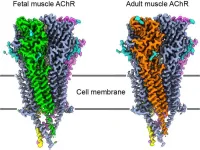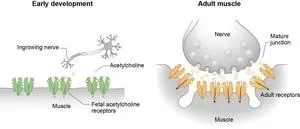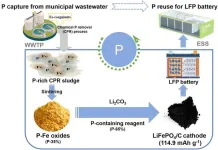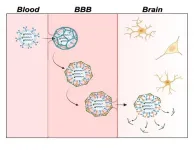(Press-News.org) The connections between the nervous system and muscles develop differently across the kingdom of life. It takes newborn humans roughly a year to develop the proper muscular systems that support the ability to walk, while cows can walk mere minutes after birth and run not long after.
University of California San Diego researchers, using powerful new visualization technologies, now have a clear picture of why these two scenarios develop so differently. The results offer new insight into understanding muscle contraction in humans that may help in developing future treatments for muscular diseases.
“In this study we set out to understand the molecular details involved in muscle contraction at the point of contact between motor neurons and skeletal muscles, which are the muscles we consciously control,” said School of Biological Sciences Professor Ryan Hibbs, of the new study published in Nature. “We have discovered how the muscle protein changes in its composition during development, which is important in the context of diseases that cause progressive muscle weakness.”
The ability of skeletal muscles to contract allows for our bodies to move — from walking and jumping to breathing and blinking our eyes. All skeletal muscle contractions originate at the junction between motor neurons, which originate in the spinal cord and brainstem, and muscle fibers. It’s here that neurons release a transmitter chemical called acetylcholine. These molecules bind to a protein receptor on the cells of muscles, triggering an opening in the cell membrane. Electrical currents flow into the cell, which causes muscles to contract.
The way neurons release chemicals that communicate with muscles has been a model system studied for more than a century. But a missing piece of this system has been visual depictions of how the process works. What does the structure of the muscle receptor protein that opens up look like?
To find out, Hibbs, study first author Huanhuan Li, a postdoctoral scholar, and Jinfeng Teng, a research data analyst, tapped cryo-electron microscopy (cryo-EM) technology based at UC San Diego’s new Goeddel Family Technology Sandbox, a hub for cutting-edge research instruments. Cryo-EM leverages ultra-powerful microscopes to capture images of molecules that are “frozen” in place.
The results featured the first visualizations of the 3-D structure of the muscle acetylcholine receptor. Since human tissue is difficult to obtain for such muscle contraction studies, the researchers accessed fetal tissue samples from cow skeletal muscles. In order to isolate the receptor in the samples, the researchers turned to an unlikely source: snake venom. A poisonous snake neurotoxin that paralyzes prey was used to latch onto the muscle receptors in the cow samples, allowing the researchers to isolate the receptors to study them. The cryo-EM visualizations then allowed the researchers to witness how the receptor development process unfolds.
Along with the new data came a serendipitous finding. The researchers discovered that they could see the structures of both fetal and adult receptors from the same fetal cow tissue samples.
“We hoped to see the structure of the receptor and we did see that, but we also saw that there were two different versions of it,” said Hibbs. “That was a surprise.”
In retrospect, the discovery of two receptor types makes sense, according to Hibbs. Since calves are developing in utero, the fetal receptors were expected. To walk like an adult shortly after birth, they start building adult nerve-muscle connections much earlier in development.
“This discovery explains how animals like cows that need to walk on the day they are born form mature neuromuscular junctions before birth, unlike humans, who have poor muscle coordination for months after birth,” said Hibbs. “Being able to see the receptor details allows us to connect their differences to how one allows for nerve-muscle connection and the other allows for muscle contraction.”
The findings of the study are already being applied to investigations of muscle-based disorders, such as congenital myasthenic syndromes (CMS) that result in muscle weakness. A common autoimmune disease known as myasthenia gravis involves antibodies that mistakenly attack the muscle acetylcholine receptor, causing weak skeletal muscles.
“This new level of insight into the muscle receptor will help researchers understand how mutations in its gene cause disease, and may facilitate personalized treatment for individual patients with different pathologies in the future,” said lead author Li.
END
Unraveling a key junction underlying muscle contraction
Researchers capture the first 3-D images of the structure of a key muscle receptor, setting the stage for possible future treatments for muscular disorders
2024-07-31
ELSE PRESS RELEASES FROM THIS DATE:
New method recovers phosphorus from wastewater to power the future of lithium-iron phosphate batteries
2024-07-31
In a recent study published in Engineering, a research team from the Shenzhen Engineering Research Laboratory for Sludge and Food Waste Treatment and Resource Recovery has introduced a pioneering method to tackle the critical global issue of phosphorus (P) scarcity. Their innovative approach leverages municipal wastewater to produce phosphorus vital for the manufacture of lithium iron phosphate (LiFePO4) batteries, a key component in the rapidly growing electric vehicle market.
As the demand for LiFePO4 batteries ...
SwRI awarded $35.7 million to support cryptologic systems for U.S. Navy
2024-07-31
SAN ANTONIO — July 31, 2024 —Southwest Research Institute will provide engineering and equipment support for advanced cryptologic technology for shipboard and airborne platforms as part of a $35.7 million contract with the U.S. Navy. The five-year contract will deliver services from June 2024 through June 2029, with the option for the U.S. Navy to add $14 million and extend the contract through 2031.
SwRI develops electronic warfare (EW) technology to detect, intercept and disrupt a range of signals on the electromagnetic spectrum, supporting efforts to thwart ...
With biodiversity under threat, scientists suggest the need for a new biorepository—on the moon
2024-07-31
With numerous species facing extinction, an international team of researchers has proposed an innovative solution to protect the planet's biodiversity: a lunar biorepository. This concept, detailed in a recent article in the journal BioScience, is aimed at creating a passive, long-lasting storage facility for cryopreserved samples of Earth's most at-risk animal species.
Led by Dr. Mary Hagedorn of the Smithsonian's National Zoo and Conservation Biology Institute, the team envisions taking advantage of the Moon's naturally cold temperatures, particularly in permanently shadowed regions near the poles, where temperatures remain consistently below –196 degrees ...
Strong El Nino makes European winters easier to forecast
2024-07-31
Heavy rain and flooding in Brazil in November could tell forecasters whether December, January and February in Britain will be cold and dry or mild and wet.
This is because forecasting European winter weather patterns months in advance is made simpler during years of strong El Niño or La Niña events in the tropical Pacific Ocean, a new study has found.
A strong El Nino or La Nina in the Pacific Ocean can bring big changes in temperatures, wind patterns and rainfall patterns to South America. When ...
MD Anderson and collaborators to launch project studying T cells on International Space Station
2024-07-31
HOUSTON ― The University of Texas MD Anderson Cancer Center and collaborators are initiating a research project that will send T cells to the International Space Station (ISS) to study the effects of prolonged microgravity on cell differentiation, activation, memory and exhaustion. These results will be further analyzed on Earth to uncover signaling pathways and identify potential immune targets that can improve treatment strategies for patients with cancer and other diseases.
To accomplish this work, MD Anderson researchers ...
Chameleon testbed secures $12 million in funding for phase 4: Expanding frontiers in computer science research
2024-07-31
Chameleon, led by Senior Scientist Kate Keahey from Argonne National Laboratory, has been a cornerstone of CS research and education for nearly a decade. The platform has served over 10,000 users, contributing to more than 700 research publications. Chameleon has now secured an additional $12 million in funding from the U.S. National Science Foundation (NSF) to roll out its next four-year phase. With this new funding, Chameleon will continue to innovate and support its growing community, enabling groundbreaking discoveries in CS systems research.
ABOUT CHAMELEON: A PLATFORM FOR INNOVATION
Chameleon is a large-scale, deeply reconfigurable experimental ...
For bigger muscles push close to failure, for strength, maybe not
2024-07-31
When performing resistance training such as lifting weights, there’s a lot of interest in how close you push yourself to failure – the point where you can’t do another rep – and how it affects your results.
While research has looked at this concept in different ways, to date, no meta-analysis has explored the pattern (i.e., linear or non-linear) of how the distance from failure (measured by repetitions in reserve) affects changes in muscle strength and size.
As such, it’s ...
Improving Alzheimer’s disease imaging — with fluorescent sensors
2024-07-31
Neurotransmitter levels in the brain can indicate brain health and neurodegenerative diseases like Alzheimer’s. However, the protective blood-brain barrier (BBB) makes delivering fluorescent sensors that can detect these small molecules to the brain difficult. Now, researchers in ACS Central Science demonstrate a way of packaging these sensors for easy passage across the BBB in mice, allowing for improved brain imaging. With further development, the technology could help advance Alzheimer’s disease diagnosis and treatment.
It is common for neurotransmitter levels ...
Most blood thinner dosing problems happen after initial prescription
2024-07-31
Millions of Americans take anticoagulants, commonly known as blood thinners. These medications work to prevent blood clots that cause heart attack and stroke.
More than two-thirds of those people take a type of blood thinner called a direct oral anticoagulant. DOACs, such as rivaroxaban (brand name Xarelto) and apixaban (brand name Eliquis), are under- or over-prescribed in up to one in eight patents.
These prescribing issues can have life threatening consequences, and they most often occur after a provider writes the initial prescription, according to a study led by Michigan Medicine.
“Direct oral anticoagulants may be viewed ...
AI boosts the power of EEGs, enabling neurologists to quickly, precisely pinpoint signs of dementia
2024-07-31
ROCHESTER, Minn. — Mayo Clinic scientists are using artificial intelligence (AI) and machine learning to analyze electroencephalogram (EEG) tests more quickly and precisely, enabling neurologists to find early signs of dementia among data that typically go unexamined.
The century-old EEG, during which a dozen or more electrodes are stuck to the scalp to monitor brain activity, is often used to detect epilepsy. Its results are interpreted by neurologists and other experts trained to spot patterns among the test's squiggly waves.
In new research published in Brain Communications, scientists at the Mayo Clinic Neurology AI Program (NAIP) demonstrate ...
LAST 30 PRESS RELEASES:
Statins significantly reduce mortality risk for adults with diabetes, regardless of cardiovascular risk
Brain immune cells may drive more damage in females than males with Alzheimer’s
Evidence-based recommendations empower clinicians to manage epilepsy in pregnancy
Fungus turns bark beetles’ defenses against them
There are new antivirals being tested for herpesviruses. Scientists now know how they work
CDI scientist, colleagues author review of global burden of fungus Candida auris
How does stroke influence speech comprehension?
B cells transiently unlock their plasticity, risking lymphoma development
Advanced AI dodel predicts spoken language outcomes in deaf children after cochlear implants
Multimodal imaging-based cerebral blood flow prediction model development in simulated microgravity
Accelerated streaming subgraph matching framework is faster, more robust, and scalable
Gestational diabetes rose every year in the US since 2016
OHSU researchers find breast cancer drug boosts leukemia treatment
Fear and medical misinformation regarding risk of progression or recurrence among patients with breast cancer
Glucagonlike peptide-1 receptor agonists and asthma risk in adolescents with obesity
Reviving dormant immunity: Millimeter waves reprogram the immunosuppressive microenvironment to potentiate immunotherapy without obvious side effects
Safety decision-making for autonomous vehicles integrating passenger physiological states by fNIRS
Fires could emit more air pollution than previously estimated
A new way to map how cells choose their fate
Numbers in our sights affect how we perceive space
SIMJ announces global collaborative book project in commemoration of its 75th anniversary
Air pollution exposure and birth weight
Obstructive sleep apnea risk and mental health conditions among older adults
How talking slows eye movements behind the wheel
The Ceramic Society of Japan’s Oxoate Ceramics Research Association launches new international book project
Heart-brain connection: international study reveals the role of the vagus nerve in keeping the heart young
Researchers identify Rb1 as a predictive biomarker for a new therapeutic strategy in some breast cancers
Survey reveals ethical gaps slowing AI adoption in pediatric surgery
Stimulant ADHD medications work differently than thought
AI overestimates how smart people are, according to HSE economists
[Press-News.org] Unraveling a key junction underlying muscle contractionResearchers capture the first 3-D images of the structure of a key muscle receptor, setting the stage for possible future treatments for muscular disorders






